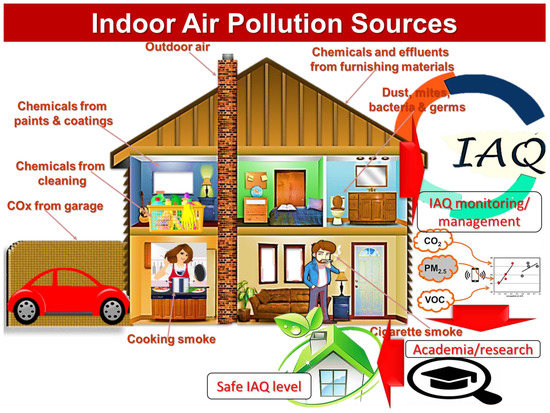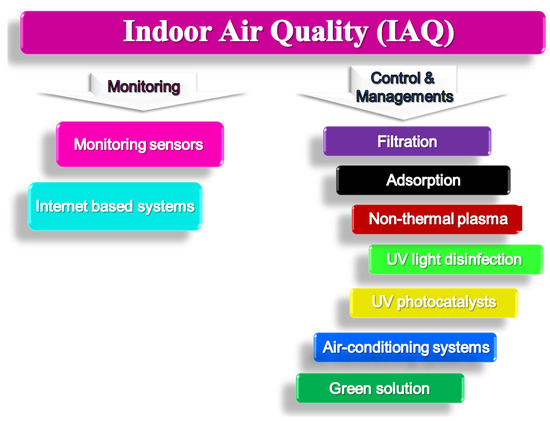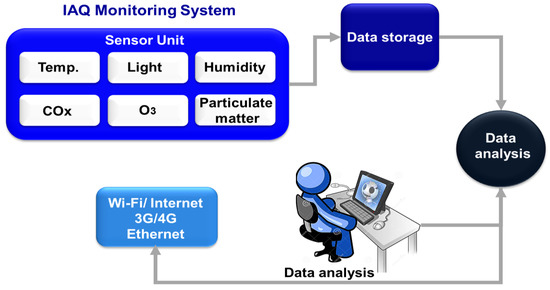You're using an outdated browser. Please upgrade to a modern browser for the best experience.
Please note this is a comparison between Version 1 by Mohamed Hassan Eisa and Version 2 by Rita Xu.
Due to increasing health and environmental issues, indoor air quality (IAQ) has garnered much research attention with regard to incorporating advanced clean air technologies. Various physicochemical air treatments have been used to monitor, control, and manage air contaminants, such as monitoring devices (gas sensors and internet of things-based systems), filtration (mechanical and electrical), adsorption, UV disinfection, UV photocatalysts, a non-thermal plasma approach, air conditioning systems, and green technologies (green plants and algae).
- indoor air quality
- pollutants
- filtration
- UV disinfection
1. Introduction
The indoor environmental conditions of buildings and houses greatly affect human health [1]. According to the World Health Organization (WHO), indoor air pollution may affect ~4–5 million people per year [2]. Most urban humans spend ~90% of their time indoors [3]. Therefore, the effect of indoor air environments on human health is obvious. Common sources of indoor air pollution include cooking, heating, smoking, garages, cleaning, electronic machines, outdoor air, and other human activities. Harmful indoor air pollutants include oxides of carbon, nitrogen, and sulfur; volatiles; particulates; aerosols; biological pollutants; and many more [4] (Figure 1). Indoor air pollution can lead to a range of physical illnesses, including cardiac, respiratory, nervous system, and even cancer-related diseases [5][6][7][5,6,7]. Consequently, indoor air quality (IAQ) monitoring, control, and management are considered important for preventing the related potential health risks [8]. The measurement of indoor pollutant concentration has been considered to be a crucial strategy for controlling and enhancing IAQ. It is also vital to determine the sources of indoor air pollution to ensure total eradication. The relationships between indoor pollutants and health risks and health effects have been found to be significant enough to justify adopting suitable remediation strategies.

Figure 1. Common pollutants and sources in indoor air.
2. Indoor Air Pollution: A Serious Threat to Human Health
2.1. Indoor Pollutants
IAQ is generally affected by factors such as outdoor air quality, building/construction materials, and human activity inside buildings [9]. Outdoor air pollutants directly influence IAQ due to the possible transfer of toxins from the outdoors to indoor atmosphere [10]. Outdoor pollutants result from industrial and transport activities [11]. Construction/building materials have been a source of indoor pollution due to the evolution of toxic organic compounds from paints, adhesives, coatings, poly(vinyl chloride) floor covers, rubber carpets, etc. [12]. Moreover, daily human activities (cooking, smoking, heating, cleaning, solvent uses, etc.) produce lots of indoor pollutants such as noxious gases, particulate matter, allergens, bacteria, viruses, insects, mites, etc. [13][14][15][13,14,15]. Major pollution-causing noxious gases include oxides of carbon (COx) such as carbon monoxide (CO) and carbon dioxide (CO2); oxides of sulfur (SOx) such as sulfur dioxide (SO2); oxides of nitrogen (NOx) as nitric oxide (NO), nitrogen dioxide (NO2), particulate matter (PM), and volatile organic matter (PM) [16]. All indoor human activities and building materials are a rich source of PM, VOC, NOx, COx, SOx, ozone, Radon, etc. The ozone (O3) is also a toxic indoor pollutant from computers, photocopying machines, printers, etc.
PM has varying size of <10 µm (large diameter coarse particles), fine particles of diameter <2.5 µm, and ultrafine particles of diameter <0.1 µm [17]. Inhalation of PM causes damaging effects to the lungs, heart, respiratory, and cardiovascular systems.
VOC consist of toxic gases and volatile chemicals from liquids or solids [18]. Formaldehyde is a toxic form of VOC emitted from building materials such as plywood, paints, coatings, coverings, etc. VOC are also penetrated in indoor environment from the outdoor air. The long term exposure to VOC can cause serious health risks like cancer [19].
NOx such as NO and NO2 result from cooking, combustion, and other heating, and fire sources [20]. NO is a primary pollutant which is oxidized to form NO2. NO2 can easily react with water to produce nitrous acid (HONO)which is a harmful indoor contaminant. Common health risks of NOx are asthmatic reactions and lung infections [21].
SOx, especially SO2 is a harmful indoor pollutant originating from outdoor air, cooking, smoking, heaters, and coal/wood burning [22]. Human exposure to SOx harms respiratory and cardiac functions causing asthmatic, pulmonary, and cardiovascular diseases.
COx such as CO emerges from indoor combustion (tobacco, cooking, gas heaters, stoves, furnaces, chimneys, etc.) and comes from outdoor air [23]. Even at low concentrations, CO can harm the cardiovascular, respiratory, and nervous systems [24].
Ozone is generally produced in the indoor environment due to photochemical reactions of VOC, COx, NOx, etc. [25]. It arises from outdoor sources, indoor photocopying, the and use of machines. O3 can seriously affect lungs, DNA, and human organs causing asthmatic and respiratory diseases.
Radon is an indoor pollutant from building materials, soil, and tap water [26]. In indoor buildings, concentrations of radioactive radon (222Rn) gas can attain harmful levels [27]. Lethal dose LD50 for radon inhalation is ~1.0 g causing toxic effects such as lung cancer and respiratory diseases [28].
Pesticides are used in an indoor environment to prevent pests, bacteria, fungi, insects, etc. Pesticides cause irritating effects on eyes, nose, and throat. Moreover, these chemicals cause damaging effects to the central nervous system, kidneys, and cancer risks [29].
Aerosols originated in indoor environments from various outdoor sources and also result from indoor gas-to-particle conversion of VOC [30]. Aerosols can be of different types such as carbonaceous aerosols, biological aerosols, and gas-to-particle aerosols. Carbonaceous aerosols originate from combustion, while biological aerosols are formed from animals, bacteria, and microorganisms. Aerosols frequently affect the human heart and brain-related systems.
Indoor biological pollutants include biological allergens (pets’ saliva, dust, cockroaches, mites, pollens, etc.) and microorganisms (bacteria, viruses, fungi, etc.) [31]. Biological pollutants emerge from outdoor air. The most common human health effects include respiratory and allergic diseases.
To control and monitor all the above-mentioned pollutants, precise techniques need to be developed. To some extent, IAQ depends on indoor ventilation rates and related systems.
2.2. Health Effects–Short and Long Term
Indoor air pollutants may cause short-term or long-term health effects. Short-term exposure involves interaction with low concentrations of indoor pollutants or contact with indoor pollutants for a short span of time. Short-term exposure to indoor pollutants such as particulate matter, volatile organic compounds, NOx, COx, etc., does not cause serious health effects [32]. In some cases, short-term exposure to indoor pollutants may initiate headaches. Especially, NOx level of 28.97 μg/m3, PM2.5 concentration of 21.51 μg/m3, PM10 level of 37.79-μg/m3, and COx concentration of 1.15-ppm were found to cause headaches in indoor inhabitants [33]. On the other hand, long-term exposure to indoor air pollutants has their serious health effects. Usually, exposure to indoor pollutants for more than one month results in serious health risks [34]. Consequently, daily exposure or long term exposure may lead to cancer-causing effects [35]. Other important effects include sick building syndrome [36][37][36,37], building-related illness [38][39][38,39], pulmonary diseases [40][41][40,41], cardiovascular diseases [42][43][44][42,43,44], and many more. Table 1 illustrates common indoor pollutants and resulting hazardous effects on human health.
Table 1. Common indoor pollutants and their effects on human health.
| Pollutant | Source | Health Influence | Ref | ||||||
|---|---|---|---|---|---|---|---|---|---|
| Particulate matter |
|
| [45][46][47] | [45,46,47] | |||||
| VOCs |
|
| [48][49] | [48,49] | |||||
| NO | 2 |
|
| [50][51] | [50,51] | ||||
| O | 3 |
|
| [52][53] | [52,53] | ||||
| SO | 2 |
|
| [54][55] | [54,55] | ||||
| COx |
|
| [56][57][58] | [56,57,58] | |||||
| Aerosol |
|
| [59][60] | [59,60] | |||||
| Radon |
|
| [61] | ||||||
| Pesticides |
|
| [62][63] | [62,63] | |||||
| Biological allergens |
|
| [64] | ||||||
| Microorganism |
|
| [65][66] | [65,66] |
According to literature reports, high indoor particulate matter PM1, PM2.5, and PM10 concentration of up to 2000–9000 μg/m3 (mainly due to indoor cooking and heating activities) cause pulmonary infections, lungs diseases, and cancer risks [67][68][67,68]. Moreover, PM and CO2 emissions due to tobacco smoke instigated coughing, sneezing, and eye irritation in indoor inhabitants [69]. Presence of indoor gaseous pollutants such as CO, NO2, SO2, O3 was found to be associated with asthma risks and nervous system issues [70]. High indoor dust ingestion of ~8.79–34.39 ng/g, containing polychlorinated biphenyl concentrations, had serious health effects such as cancer risks and loss of indoor working productivity [71]. Indoor inhalation of flame retardants (up to concentrations of 128,000 ng.g−1) revealed respiratory issues and loss of indoor working productivity [72]. Furthermore, high levels of indoor microflora and bacteria ~10,000–15,000 cfu m−3 caused respiratory and cancer risks [73][74][73,74].
3. Monitoring of Indoor Air Quality (IAQ)
Indoor air quality (IAQ) is defined as air value inside and around the buildings [75]. IAQ is important for health and coziness of building inhabitants. Harmful air pollutants (volatile organic compounds, particulate matter, and physical, chemicals, and biological aspects) at high concentration levels in indoor air cause negative health effects on human body.
An analysis of air quality level of south-east Asian countries (Pakistan, India, Nepal, Sri Lanka, Bangladesh, and Bhutan) has been carried out [76]. Comparative evaluation was performed for indoor pollutants such as PM10, PM2.5 and CO. WHO standards were considered for comparison. The WHO standards set for indoor PM10 level were 50 μg/m3 and PM2.5 was 25 μg/m3. Air quality level (200–5000 μg/m3) was attained much higher than the WHO standard value for safe IAQ [77]. Moreover, carbon monoxide level was found much higher (~29.4 ppm) than the WHO set standards (<5 ppm). The suggested reason was conventional indoor fuel burning sources, which affected >50% of indoor population. Consequently, employment of IAQ policies was found indispensable to safeguard public health in these countries [78]. Moreover, rising indoor pollutant levels pointed to increasing respiratory, nervous, and mortality rates in population [79].
Research, analysis, and monitoring for IAQ levels have arisen as a significant research field [80]. Purpose of supervising IAQ is to protect humans occupying non-industrial buildings from harmful pollutants. It is important to mention that IAQ assessments are found to be affected by indoor conditions such as temperature, light, humidity, air flow, etc. [81]. Initially, indoor pollutants have been controlled through adjusting indoor temperature and humidity. Figure 2 demonstrates a flow chart for steps involved in monitoring, control, and management of indoor air quality.

Figure 2. Indoor air quality—Monitoring, control, and management.
3.1. Materials Based IAQ Sensors
For IAQ monitoring systems, sensors have gained considerable research interest [82]. Initially, two-dimensional nanostructured materials have been invented for gas sensing [83]. Later research attempts focused zero-, one-, and three-dimensional nanostructured materials for developing IAQ monitoring sensors. These nanomaterials have been used to develop gas sensors, light sensors, humidity sensors, and temperature sensors. For IAQ monitoring systems, manifold phases of data acquisition, processing, storage, and analysis have been used [84]. Figure 3 shows a conceptual architecture of IAQ monitoring system. The data processing phase is accomplished at hardware as well as software level. The data acquired is sent for storage and processing. The software was used for enhancing data analysis and visualization. Accuracy of sensors has been achieved through calibrations and maintenance procedures. Consequently, development of novel low-cost sensors offers precise output data for advanced IAQ monitoring systems.

Figure 3. General conceptual architecture of IAQ monitoring system.
3.2. Advanced Technologies for IAQ Monitoring IAQ—Internet of Things (IoT)-Based Systems
Advanced techniques have been developed for IAQ monitoring [85]. Most prominently, internet of things (IoT)-based systems and wireless sensor networks have been developed. The IoT has been used as most popular technique for industrial revolution for IAQ monitoring [86]. Portable IoT devices have been effectively used for IAQ monitoring and control [87]. Recently, electronic noses or e-noses have been used as IoT devices for IAQ monitoring [88]. An e-nose is made up of multi-sensors arrays, processing units, digital software, and artificial neural networks. The e-nose has ability to monitor, detect, and discriminate various gaseous molecules [89]. Moreover, e-noses have low-cost and compactness for developing efficient IAQ monitoring systems [90]. The e-noses can sense numerous air pollutants such as CO, CO2, NO2, and particulate matter [91].
